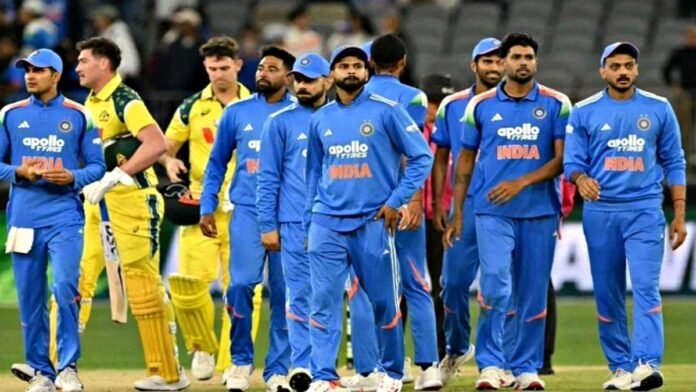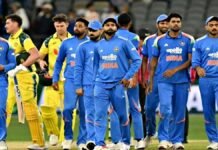
Key Points
- India suffers consecutive defeats in Australia ODI series, trailing 0-2 with series already lost
- Virat Kohli records back-to-back golden ducks for first time in ODI career, raising concerns about 2027 World Cup spot
- Harshit Rana proves most expensive bowler in Adelaide, conceding 59 runs in 8 overs despite two wickets
- Match-winner Kuldeep Yadav benched for second consecutive match despite Adam Zampa’s four-wicket haul
- Head coach Gautam Gambhir’s team selection and strategy under intense scrutiny
New Delhi: India’s dismal performance in the ongoing Australia ODI series has reached crisis levels following a comprehensive defeat in Adelaide, surrendering an unassailable 0-2 series lead with one match remaining. The consecutive losses have exposed fundamental flaws in team selection, individual form, and tactical decision-making that demand immediate accountability.
Virat Kohli’s Historic Slump Raises World Cup Questions
The Adelaide debacle witnessed Virat Kohli register his second consecutive golden duck—an unprecedented occurrence in his illustrious ODI career spanning over 15 years. The former captain’s twin failures in Perth and Adelaide mark the first instance of back-to-back zero scores in ODI cricket for the batting maestro, amplifying concerns about his future in the 50-over format.
Pre-tour media speculation had already suggested Kohli’s position in India’s 2027 ODI World Cup plans hinged critically on his Australian performance. His retirement from Tests and T20 internationals has intensified focus on his ODI contributions. The current form crisis, characterized by technical vulnerabilities and apparent mental pressure, has transformed speculation into legitimate debate about his roadmap toward the next World Cup cycle.
At 37 years old, Kohli’s ability to rediscover his trademark consistency becomes increasingly urgent with the 2027 tournament approaching. The Adelaide failure, where he failed to trouble the scorers, has provided ammunition to critics questioning whether age and format-specific retirements have disrupted his batting rhythm.
Harshit Rana: Favoritism Without Performance
Fast bowler Harshit Rana’s inclusion in India’s ODI squad sparked immediate controversy, with analysts questioning whether head coach Gautam Gambhir’s personal preference influenced selection over established performers. The Adelaide match vindicated critics’ concerns as Rana became the most expensive bowler in India’s attack.
Despite claiming two wickets, Rana hemorrhaged 59 runs across eight overs, an economy rate exceeding 7.3 runs per over, which proved catastrophic on Adelaide’s typically batting-friendly surface. His bowling displayed neither the pace penetration nor the tactical awareness required at the international level. The lack of aggression and wicket-taking threat contradicted the primary rationale for fast bowlers in limited-overs cricket.
Rana’s repeated selections despite underwhelming performances have raised uncomfortable questions about meritocracy within the current team structure. His continued presence while proven match-winners remain sidelined suggests a selection policy driven by coaching staff preferences rather than objective performance criteria.
Gautam Gambhir’s Kuldeep Yadav Mystery Deepens
Perhaps the most baffling aspect of India’s Adelaide defeat involves the continued exclusion of wrist-spinner Kuldeep Yadav from the playing eleven. While Australian leg-spinner Adam Zampa claimed Player of the Match honors with a four-wicket haul that dismantled India’s batting order, India’s premier spinner watched helplessly from the sidelines for the second consecutive match.
Kuldeep’s omission defies cricketing logic on multiple levels. Adelaide Oval’s expansive boundaries traditionally favor wrist-spinners capable of extracting bounce and generating sharp turn. Australian batsmen historically struggle against quality wrist-spin, as Zampa’s match-winning performance ironically demonstrated. Kuldeep’s recent form in domestic cricket and his proven track record in Australian conditions make his exclusion incomprehensible.
The decision-making rationale employed by head coach Gautam Gambhir and captain Shubman Gill remains opaque. Neither has articulated convincing explanations for persisting with a pace-heavy attack unsuited to Adelaide’s conditions while benching India’s most dangerous wicket-taking option. The strategic conservatism appears increasingly disconnected from match situations and opposition strengths.
Systemic Concerns Beyond Individual Failures
While Kohli’s form slump, Rana’s ineffectiveness, and Kuldeep’s puzzling exclusion represent immediate flashpoints, they symptomize deeper structural issues. The team’s batting fragility against quality pace bowling, over-reliance on individual brilliance, and rigid tactical approach have been ruthlessly exposed by a well-drilled Australian unit.
Gambhir’s coaching tenure, still in its early stages, faces mounting pressure to demonstrate strategic flexibility and selection transparency. The final ODI presents an opportunity for course correction, though the series outcome is already sealed. How the management addresses these glaring deficiencies will significantly influence India’s trajectory toward the 2027 World Cup and upcoming bilateral commitments.




















































